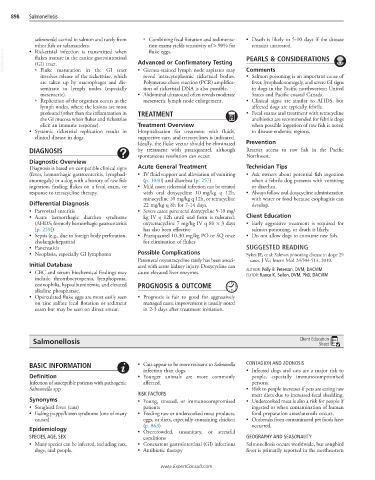Page 1792 - Cote clinical veterinary advisor dogs and cats 4th
P. 1792
898 Salmonellosis
salmincola) carried in salmon and rarely from ○ Combining fecal flotation and sedimenta- • Death is likely in 5-10 days if the disease
other fish or salamanders. tion exams yields sensitivity of > 90% for remains untreated.
VetBooks.ir flukes mature in the canine gastrointestinal Advanced or Confirmatory Testing PEARLS & CONSIDERATIONS
• Rickettsial infection is transmitted when
fluke eggs.
(GI) tract.
○ Fluke maturation in the GI tract
• Salmon poisoning is an important cause of
involves release of the rickettsiae, which • Giemsa-stained lymph node aspirates may Comments
reveal intracytoplasmic rickettsial bodies.
are taken up by macrophages and dis- Polymerase chain reaction (PCR) amplifica- fever, lymphadenomegaly, and severe GI signs
seminate to lymph nodes (especially tion of rickettsial DNA is also possible. in dogs in the Pacific northwestern United
mesenteric). • Abdominal ultrasound often reveals moderate States and Pacific coastal Canada.
○ Replication of the organism occurs in the mesenteric lymph node enlargement. • Clinical signs are similar to AHDS, but
lymph nodes, where the lesions are most affected dogs are typically febrile.
profound (other than the inflammation in TREATMENT • Fecal exams and treatment with tetracycline
the GI mucosa when flukes and rickettsiae antibiotics are recommended for febrile dogs
elicit an immune response). Treatment Overview when possible ingestion of raw fish is noted
• Systemic rickettsial replication results in Hospitalization for treatment with fluids, in disease-endemic regions.
clinical disease in dogs. supportive care, and tetracyclines is indicated.
Ideally, the fluke vector should be eliminated Prevention
DIAGNOSIS by treatment with praziquantel, although Restrict access to raw fish in the Pacific
spontaneous resolution can occur. Northwest.
Diagnostic Overview
Diagnosis is based on compatible clinical signs Acute General Treatment Technician Tips
(fever, hemorrhagic gastroenteritis, lymphad- • IV fluid support and alleviation of vomiting • Ask owners about potential fish ingestion
enomegaly) in a dog with a history of raw fish (p. 1040) and diarrhea (p. 257) when a febrile dog presents with vomiting
ingestion, finding flukes on a fecal exam, or • Mild cases: rickettsial infection can be treated or diarrhea.
response to tetracycline therapy. with oral doxycycline 10 mg/kg q 12h, • Always follow oral doxycycline administration
minocycline 10 mg/kg q 12h, or tetracycline with water or food because esophagitis can
Differential Diagnosis 22 mg/kg q 8h for 7-14 days. develop.
• Parvoviral enteritis • Severe cases: parenteral doxycycline 5-10 mg/
• Acute hemorrhagic diarrhea syndrome kg IV q 12h until oral form is tolerated; Client Education
(AHDS; formerly hemorrhagic gastroenteritis oxytetracycline 7 mg/kg IV q 8h × 3 days • Early aggressive treatment is required for
[p. 259]) has also been effective salmon poisoning, or death is likely.
• Sepsis (e.g., due to foreign body perforation, • Praziquantel 10-30 mg/kg PO or SQ once • Do not allow dogs to consume raw fish.
cholangiohepatitis) for elimination of flukes
• Pancreatitis SUGGESTED READING
• Neoplasia, especially GI lymphoma Possible Complications Sykes JE, et al: Salmon poisoning disease in dogs: 29
Parenteral oxytetracycline rarely has been associ- cases. J Vet Intern Med 24:504-513, 2010.
Initial Database ated with acute kidney injury. Doxycycline can
• CBC and serum biochemical findings may cause elevated liver enzymes. AUTHOR: Polly B. Peterson, DVM, DACVIM
EDITOR: Rance K. Sellon, DVM, PhD, DACVIM
include thrombocytopenia, lymphopenia,
eosinophilia, hypoalbuminemia, and elevated PROGNOSIS & OUTCOME
alkaline phosphatase.
• Operculated fluke eggs are most easily seen • Prognosis is fair to good for aggressively
on zinc sulfate fecal flotation or sediment managed cases; improvement is usually noted
exam but may be seen on direct smear. in 2-3 days after treatment initiation.
Salmonellosis Client Education
Sheet
BASIC INFORMATION • Cats appear to be more resistant to Salmonella CONTAGION AND ZOONOSIS
infection than dogs. • Infected dogs and cats are a major risk to
Definition • Younger animals are more commonly people, especially immunocompromised
Infection of susceptible patients with pathogenic affected. persons.
Salmonella spp • Risk to people increases if pets are eating raw
RISK FACTORS meat diets due to increased fecal shedding.
Synonyms • Young, stressed, or immunocompromised • Undercooked meat is also a risk for people if
• Songbird fever (cats) patients ingested or when contamination of human
• Fading puppy/kitten syndrome (one of many • Feeding raw or undercooked meat products, food preparation areas/utensils occurs.
causes) eggs, or diets, especially containing chicken • Outbreaks from contaminated pet foods have
(p. 863) occurred.
Epidemiology • Overcrowded, unsanitary, or stressful
SPECIES, AGE, SEX conditions GEOGRAPHY AND SEASONALITY
• Many species can be infected, including cats, • Concurrent gastrointestinal (GI) infections Salmonellosis occurs worldwide, but songbird
dogs, and people. • Antibiotic therapy fever is primarily reported in the northeastern
www.ExpertConsult.com

